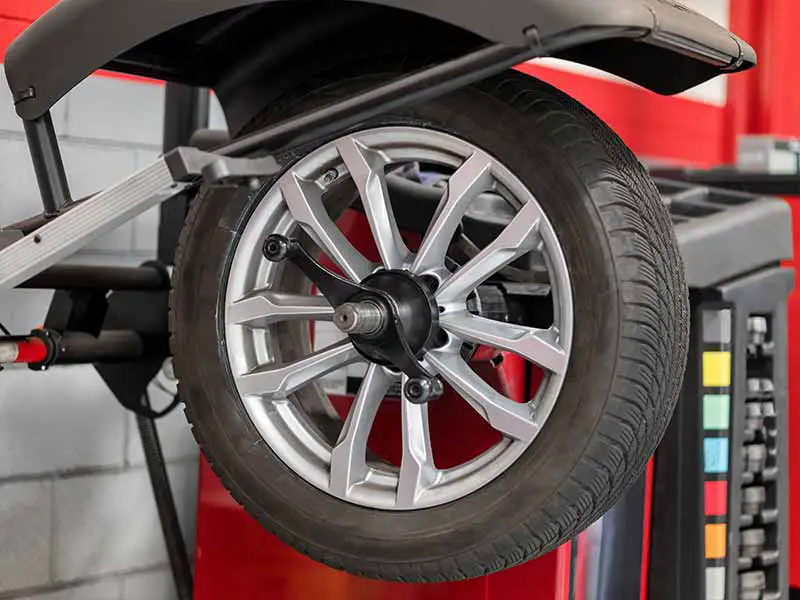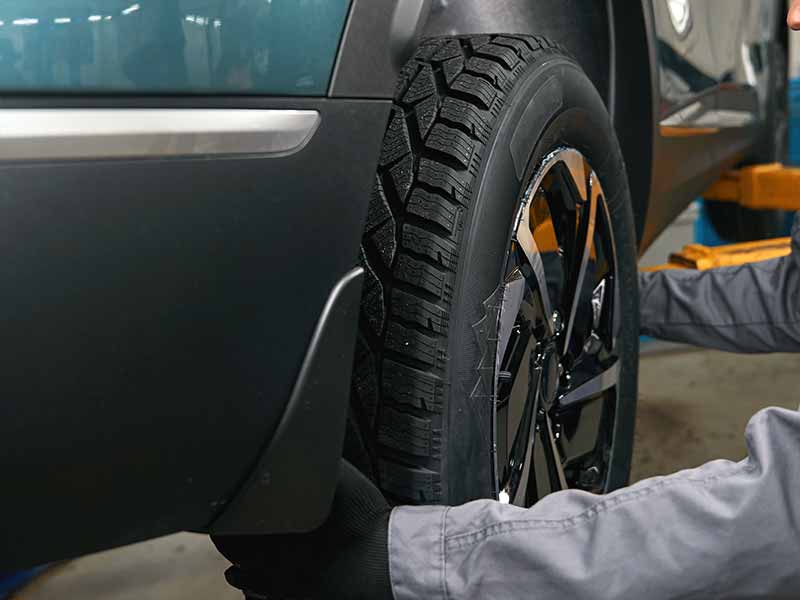You’ve tried the traditional route, rebalancing your tires more times than you can count. You even dived into the world of road force balancing, but the imbalance persists. Now, you’re wondering if tire runout could be the elusive culprit. Is it possible that this overlooked aspect is the key to a smoother ride?
How Much Tire Runout Is Acceptable
Acceptable tire runout varies, but generally, maximum radial runout should not exceed 0.125 inches, and lateral runout should be under 0.1 inches. Exceeding these limits can lead to vibrations and uneven tire wear.
In this article, you will discover the intricacies of tire runout, including how to measure it, the acceptable limits for both lateral and radial runout, and effective strategies to address excessive runout to ensure a smooth and safe driving experience.

Understanding Tire Runout
Welcome to the world of tire runout, a crucial aspect often overlooked in the maintenance of passenger cars and trucks. Let’s dive into what it really means and why it matters to you as a vehicle owner.
What is Tire Runout?
Tire runout is essentially the deviation or variance in the shape of the tire from its perfect circular rotation. Think of it as a subtle wobble or unevenness as the tire spins. There are two types of runout to be aware of:
- Radial Runout: This is the variation in the tire’s radius as it rotates. Imagine a tire that grows and shrinks slightly in different parts of its rotation – that’s radial runout for you.
- Lateral Runout: This type refers to the side-to-side variation or the wobbling effect you might notice in a tire as it spins.
Causes of Tire Runout
Understanding the causes behind tire runout can help in diagnosing and fixing issues quicker. Here are some common culprits:
- Manufacturing Variances: No tire is perfect; slight deviations can occur during the manufacturing process.
- Wear and Tear: Over time, tires can develop irregularities due to usage.
- Improper Installation: Incorrect mounting of the tire on the rim can lead to runout.
- Impact Damage: Hitting potholes or curbs might deform the tire or wheel, causing runout.
Why Does Tire Runout Matter?
Tire runout might seem like a minor issue, but it can have significant effects on your vehicle’s performance and your safety. Here’s why it’s essential to keep an eye on:
- Ride Comfort: Excessive runout can lead to a bumpy or uncomfortable ride.
- Tire Wear: Uneven tire wear can shorten the lifespan of your tires, leading to frequent replacements.
- Safety Concerns: In extreme cases, severe runout can affect vehicle handling and stability.

Dial Gauge
Measuring Tire Runout
Now that we’re familiar with what tire runout is, let’s get into the nitty-gritty of measuring it. Accurate measurement is key to diagnosing and resolving any runout issues effectively. Here’s how you can do it:
Tools and Techniques for Measuring Runout
First things first, you’ll need the right tools for the job. To measure tire runout accurately, you’ll typically use a:
- Dial Indicator: This precise instrument measures the deviation of the tire from a perfect circle. It’s a must-have in your tire maintenance toolkit.
Step-by-Step Guide to Measuring Runout
Measuring runout might sound technical, but with the right approach, it’s pretty straightforward. Here’s a simple guide:
- Prepare Your Vehicle: Ensure your car is parked on a flat surface and the tire you’re measuring is properly inflated.
- Set Up the Dial Indicator: Attach the dial indicator to a stable point near the tire. For radial runout, position the dial’s probe perpendicular to the tread; for lateral runout, it should be parallel to the tread.
- Rotate the Tire: Slowly spin the tire and observe the dial indicator. Note the highest and lowest points as the tire rotates.
- Read the Measurements: The difference between these points is your runout measurement. Compare it to the acceptable limits (usually around .125 inches for radial runout).
Why Accurate Measurement Matters
- Precise Diagnostics: Knowing the exact runout helps in diagnosing potential issues and deciding the right course of action.
- Cost-Effective Maintenance: Accurate measurements can save you from unnecessary tire replacements or services.
When to Seek Professional Help
While measuring tire runout is doable at home, sometimes it’s best to consult a professional, especially if you’re noticing significant runout or experiencing vibrations while driving. A professional can offer more comprehensive services like Road Force Balancing, which is an advanced method of ensuring your tires are perfectly balanced and aligned.

Acceptable Limits of Tire Runout
Understanding the acceptable limits for tire runout is crucial in maintaining the health of your tires and ensuring a smooth driving experience. These limits serve as benchmarks to determine whether your tires are in good shape or need attention.
Maximum Lateral Tire Runout
Lateral runout refers to the side-to-side wobble of the tire as it rotates. Here’s what you need to know about its acceptable limits:
- Standard Limit: Generally, the maximum lateral runout should not exceed 0.1 inches (2.5 mm).
- Impact on Vehicle: Excessive lateral runout can lead to vibrations, uneven tire wear, and can affect the alignment of your vehicle.
Maximum Radial Tire Runout
Radial runout is the variation in the tire’s radius during rotation. Understanding its acceptable limit is vital:
- Standard Limit: The accepted norm for maximum radial runout is about 0.125 inches (3.175 mm).
- Consequences of Exceeding Limits: If radial runout goes beyond this limit, it can cause noticeable vibrations, especially at higher speeds, and lead to premature tire wear.
What Is Excessive Runout on Tires?
Excessive runout is when the tire’s deviation from a perfect circle exceeds the standard limits. It’s a red flag indicating that:
- The tire might be damaged or defective.
- The wheel assembly might require balancing or alignment.
Identifying Excessive Runout
Detecting excessive runout can be straightforward if you know what to look for:
- Vibrations: One of the first signs is unusual vibrations felt while driving.
- Irregular Tire Wear: Check for patterns like tire cupping which can indicate runout issues.
- Visual Inspection: A visible wobble or uneven tire surface when the vehicle is in motion can also indicate excessive runout.
When to Act
If you suspect your tires have excessive runout:
- Consult a Professional: It’s advisable to get a professional opinion. They can provide comprehensive assessments like checking for tire balance issues.
- Proactive Replacement: Sometimes, replacing the tire is the most straightforward solution, especially if the runout is due to a manufacturing defect or irreparable damage.

Identifying and Addressing Excessive Runout
When tire runout exceeds the acceptable limits, it’s time to take action. Identifying and addressing excessive runout early can save you from a bumpy ride and a slew of other tire-related issues.
Recognizing the Signs of Excessive Runout
Understanding what to look for is the first step in tackling excessive tire runout. Here are some common indicators:
- Vibrations and Unusual Noises: If your car starts to vibrate unusually, especially at certain speeds, it’s a tell-tale sign. Sometimes, you might even hear a rhythmic noise as the tire rotates.
- Irregular Tire Wear: Keep an eye on your tire treads. Patterns like tire cupping can indicate problems with runout.
- Visual Check: Sometimes, the issue is visible. A tire that doesn’t spin in a true circle or seems to wobble might have excessive runout.
Can a New Tire Be Out of Round?
Yes, even new tires can be out of round. This can happen due to manufacturing defects or damage during shipping and handling. If you suspect your new tire is out of round:
- Check Immediately: Measure the runout as soon as you notice any issue.
- Return or Replace: Most tire retailers will replace a new tire that’s found to be defective.
Solutions for Excessive Runout
Once you’ve identified excessive runout, here are some steps to rectify the issue:
- Tire and Wheel Balancing: Sometimes, balancing the tire and wheel assembly can correct minor runout issues. Learn about 4 types of wheel balancing to understand your options.
- Re-Mounting the Tire: If the tire is not seated correctly on the wheel, re-mounting it can sometimes resolve the runout.
- Replacement: In cases where the tire or wheel is damaged or defective, replacement might be the only solution.
Professional Assessment and Repair
When in doubt, it’s always a good idea to seek professional help. A tire expert can:
- Provide a Comprehensive Check: They can assess not just the tire, but also the wheel and overall alignment.
- Offer Advanced Solutions: Sometimes, issues like runout stem from deeper problems in the wheel assembly or suspension. A professional can pinpoint and fix these issues.
Resources
Below are some links you may find helpful when learning about tires:
- Understanding tire runout – Evans Tire
- Addressing tire, wheel assembly run-out and balance – Fleet Equipment
Final Thoughts
Tackling tire imbalances can sometimes feel like a game of mechanical detective work. If you’ve exhausted the usual suspects – traditional rebalancing and road force balancing – and still face persistent vibrations, exploring tire runout is a prudent next step.
This guide has equipped you with the essential knowledge about tire runout, including how to measure it and understand its acceptable limits. By incorporating regular maintenance checks and being mindful of tire health, you can proactively address and prevent these issues.
Remember, the journey to a smooth, vibration-free ride often lies in paying attention to these finer details. Keep this information in your troubleshooting arsenal, and you’re more likely to pinpoint and solve those elusive tire imbalances.
Good luck and happy motoring.




